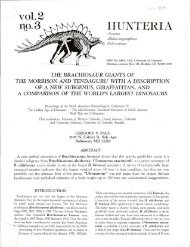THE MANY MYTHS, SOME OLD, SOME NEW, OF ... - Gregory S. Paul
THE MANY MYTHS, SOME OLD, SOME NEW, OF ... - Gregory S. Paul
THE MANY MYTHS, SOME OLD, SOME NEW, OF ... - Gregory S. Paul
Create successful ePaper yourself
Turn your PDF publications into a flip-book with our unique Google optimized e-Paper software.
DINOSAUR <strong>MYTHS</strong> 73<br />
1970; Coombs, 1978a; Bakker, 1980; Gatesy, 1988; Padian and Olsen, 1988;<br />
Campbell and Marcus, 1990). This has led to reconstructions of small theropod and<br />
ornithischian dinosaurs with horizontal femora (Padian and Olsen, 1988; Campbell<br />
and Marcus, 1990).<br />
Reality: The above is true when birds walk and run slowly, but still and motion<br />
photos show that avian femoral action is much more extensive at the highest speeds<br />
(<strong>Paul</strong>, 1987a, 1988a)-animals do not waste limb segments when moving fast! Avian<br />
femoral mobility is important because most ornithischians, including some of the<br />
largest examples, have hip joints very similar to those of birds, with a large, true<br />
anti trochanter on the posterior rim of the acetabulem articulating with the outer<br />
femoral head. If birds really did have fixed, horizontal femora, this would indicate<br />
that ornithischians did too. This would be unsatisfactory for dinosaurs because the<br />
resulting limb action would be very awkward and limited, due to their having shorter<br />
distal leg segments than birds. It would also cause the long tailed dinosaurs to be tail<br />
heavy. Instead, as in birds, the antitrochanter and femoral head remain in proper<br />
articulation as the long ornithischian femur swings in a long arc that ends at about<br />
vertical. Manipulation of uncrushed theropod hip joints show that femoral action<br />
was extensive in that group also.<br />
LIMB RATIOS AND FOOT MASSES ARE GOOD INDICATORS<br />
<strong>OF</strong> DINOSAUR SPEED<br />
Myth: There is a close correlation between the elongation of the distal limb segments<br />
and speed, and this can be used as a measure of animal locomotory performance (see<br />
Hildebrand and Hurley, 1985; McGowan, 1984, notes that dead mass added to<br />
human feet degraded running performance). Dinosaurs tend to have longer proximal<br />
limb segments and heavier feet than fast mammals and birds, so they were<br />
slower than the latter (as per Coombs, 1978a).<br />
Reality: The relationship between limb ratios, limb gracility and speed is not as close<br />
as often believed. Speed has been observed to be constant in ungulates of varying<br />
limb ratios (Alexander, 1977). Some canids and hyaenids appear to achieve chase<br />
speeds comparable to those of their more gracile limbed ungulate prey (Kruuk,<br />
1972). Even plantigrade, short lower limbed bears have been observed to chase<br />
down ungulate prey over modest distances. Limb energy efficiency is similar in<br />
animals with gracile and big pawed feet (Taylor etal., 1974). Adding mass to feet may<br />
improve performance, as per running shoes. Likewise, distal bones, muscles and<br />
connective tissues are power producing and storing masses that can enhance running<br />
speed if properly designed. The femur may be a particularly important limb segment<br />
in the large tailed dinosaurs because the caudo-femoralis remained an important<br />
limb retractor. This would favor a longer femur in dinosaurs than in birds and<br />
mammals, whose tail based femoral retractors are very reduced. It is probable that<br />
the speed of the gracile ornithomimids and tyrannosaurs was comparable to that of<br />
the shorter femured ratites, and that ceratopsids charged at speeds comparable to<br />
longer footed rhinos.<br />
BIG ANIMALS MUST BE SLOW<br />
Myth: It is not possible for animals the size of elephants and larger to move more<br />
rapidly than a fast amble. All large adult dinosaurs were therefore equally slow









